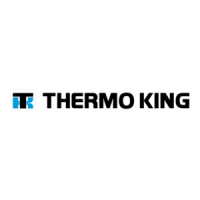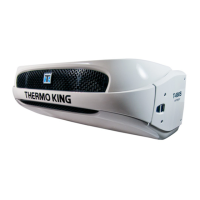Do you have a question about the Thermo King TS-500 NAD and is the answer not in the manual?
Basic safety guidelines for operating and maintaining the unit.
Warnings regarding the unit's automatic startup capabilities.
Safety precautions when handling refrigerants.
General first aid measures for common hazards.
Precautions for handling and working with refrigeration oil.
General warnings and precautions for electrical systems.
Safety measures for servicing electronic components.
Safety procedures to follow when performing welding operations.
Critical warnings and precautions for high voltage circuits.
Safety precautions for low voltage control circuits.
Importance and location of safety and information decals.
Technical details and parameters for the unit's engine.
Recommended belt tension settings for various drives.
Technical parameters for the refrigeration system.
Technical details for the Hilliard clutch.
Technical parameters for the electrical control system.
Specifications related to the defrost timer function.
Settings and parameters for the thermostat.
Specifications for various electrical components.
Technical details for electric standby operation.
Requirements for the standby power supply.
Specifications for the unit's air switch.
Scheduled checks and services for the microprocessor.
Regular inspection and service tasks for the engine.
Scheduled checks and services for electrical systems.
Scheduled checks and services for the refrigeration system.
Scheduled checks and services for structural components.
A general description of the TS-500 transport temperature control system.
Description of the µP-T microprocessor controller.
Description of the optional Data Acquisition System.
Explanation of the clutch engagement on engine operation.
Summary of standard and optional features for TS-500 models.
Description of the unit's instruments and display.
Explanation of fuses and high pressure cutout.
General information on unit operation.
Procedure for completing a pretrip inspection.
How to view operational data on the display.
Procedure for changing the unit's setpoint temperature.
Procedure for performing a full unit self check.
Guidance on selecting operating modes for CYCLE-SENTRY units.
List of products needing continuous run operation.
List of products suitable for CYCLE-SENTRY operation.
Procedure for selecting operating modes.
Steps to initiate a manual defrost cycle.
Procedure for viewing and clearing alarm codes.
Procedures for restarting the unit after a shutdown.
Items to check after the unit has started.
Steps for loading products into the refrigerated unit.
Steps to perform after loading is complete.
Checks to perform after completing a trip.
Visual illustrations of the unit's exterior.
Overview of the µP-T microprocessor control units.
Description of the main components of the µP-T control system.
Description and function of the microprocessor power switch.
Details on the electric standby option for Model 50 units.
Standard equipment features for Model 50 units.
Optional features available for Model 50 units.
Description of the remote control panel keypad and display.
Explanation of the display screen and its elements.
Meanings of the various icons shown on the display.
Example of how to interpret a typical display reading.
Explanation of the default display screen.
Procedure for adjusting the unit's temperature setpoint.
Procedure for selecting operating modes.
Procedure for starting the unit's engine.
Steps to initiate a manual defrost cycle.
Procedure to check the unit's software revision.
Navigating through various prompt and display screens.
How to lock a specific display screen.
Procedure for managing unit alarm codes.
Explanation of µP-T alarms and their codes.
Classification and description of the three types of alarms.
A comprehensive list of µP-T alarm codes and descriptions.
Detailed description of the unit self check test procedure.
Diagnostic procedures for the Prestolite alternator charging system.
Troubleshooting steps for excessive voltage output.
Inspection and maintenance of the unit's battery.
Inspection of unit wiring and harnesses for damage.
Maintenance and inspection of electrical relay contacts.
Checks and observations for the 12 Vdc charging system.
Explanation of the preheat buzzer's role.
Details on the RPM sensor and how to test it.
Explanation and testing procedures for glow plugs.
Procedure to check condenser/evaporator fan rotation.
Testing and adjustment of the defrost air switch.
Description of the enhanced heating system.
Explanation of the unit's operation in Cool Mode.
Description of the Heat/Condenser Evacuation Mode.
Explanation of the unit's operation in Defrost Mode.
Description of the unit's start-up mode.
Overview of the EMI 2000 extended maintenance interval package.
Description of the engine's pressure lubrication system.
Function and role of the engine oil pressure sensor.
Procedure for changing the engine oil and filter.
Steps for replacing the engine oil filter.
Description and maintenance of the crankcase breather system.
Maintenance and replacement of the EMI 2000 air cleaner.
General description of the pressurized cooling system.
Information and recommendations for ELC coolants.
Procedure for antifreeze inspection and maintenance.
Specification for the engine thermostat's operating temperature.
Description of the components of the diesel fuel system.
Procedure to remove air from the fuel system.
Procedure for draining accumulated water from the fuel tank.
Procedure for replacing the fuel filter.
Operation, maintenance, and disassembly of the electric fuel pump.
Procedures for adjusting engine speed via the injection pump.
Procedures for timing the injection pump to the engine.
Procedure for adjusting engine valve clearance.
Details regarding the fuel limit screw and service regulations.
Description of the engine mounting system components.
Procedure for adjusting the restraining mount.
Description of the integral fuel solenoid's function.
Procedures for adjusting low and high engine speeds.
General information regarding the unit's belts.
Procedure to adjust the engine/electric motor belt.
Procedure to adjust the electric motor/compressor belt.
Steps for mounting and adjusting the alternator.
Procedure for replacing idler pulley bearings and seals.
Importance and principles of system evacuation.
Procedures for setting up and testing evacuation equipment.
Steps for performing a unit evacuation.
Steps for charging the refrigeration system.
Procedure for safely removing refrigerant hoses.
Methods and tools for detecting refrigerant leaks.
Procedures for testing the refrigerant charge.
Procedure for checking the compressor oil level.
Description and testing of the High Pressure Cutout switch.
Procedure for performing a low side pump down.
General system pressure checks for refrigeration.
Description and checking of the bypass check valve.
Description of the discharge pressure regulator valve.
Procedures for accumulator removal and installation.
Procedures for compressor removal and installation.
Procedure for replacing the compressor shaft seal.
Procedure for replacing the compressor oil filter.
Procedure for changing the oil in a scroll compressor.
Procedure for changing the high temperature cutout switch.
Procedure for changing the liquid injection fitting.
Procedures for condenser/radiator coil removal and installation.
Procedures for receiver outlet check valve removal and installation.
Procedures for liquid injection valve removal and installation.
Procedures for dehydrator (filter-drier) removal and installation.
Procedures for evaporator coil removal and installation.
Procedures for expansion valve assembly removal and installation.
Procedure for cleaning the in-line expansion valve screen.
Procedures for heat exchanger removal and installation.
Procedures for high pressure cutout switch removal and installation.
Procedures for high pressure relief valve removal and installation.
Procedures for pilot solenoid removal and installation.
Procedures for receiver tank removal and installation.
Procedure for repairing the three-way valve bypass check valve.
Procedure for repairing the three-way valve.
Information about the R-404A refrigerant.
Methods for identifying units charged with R-404A.
Details on compressor oil types and compatibility.
Recommendations for vacuum pumps used with R-404A.
Recommendations for gauge manifold sets.
Procedures for cleaning up refrigeration systems.
Adapting systems for R-404A refrigerant recovery.
Procedures for throttling valve removal, disassembly, and installation.
Overview of changing the centrifugal clutch.
Inspection procedures for clutch wear and components.
List of tools needed for clutch maintenance.
Recommended type of grease for clutch maintenance.
Step-by-step procedure for disassembling the clutch.
Procedure for reassembling the clutch with new parts.
Procedures for checking and tightening mounting bolts.
Inspection points for unit pretrip and scheduled maintenance.
Procedures for cleaning system coils and fins.
Proper positioning of the fan for optimal performance.
Procedure for checking and adjusting the defrost damper.
Steps for disassembling the fanshaft assembly.
Troubleshooting when the unit switch is ON but nothing happens.
Troubleshooting when lights are on but engine won't crank.
Troubleshooting steps when the engine cranks but won't start.
Troubleshooting for issues causing the engine to stop after starting.
Troubleshooting steps for loss of engine power.
Troubleshooting excessive black smoke (fuel to air ratio).
Troubleshooting causes and remedies for engine knocking.
Troubleshooting steps for an overheating engine.
Troubleshooting for low or suddenly dropping oil pressure.
Diagnosing and resolving high oil consumption issues.
Troubleshooting causes of blue smoke indicating oil consumption.
Troubleshooting causes of white smoke from unburnt fuel.
Troubleshooting why the battery is not recharging.
Troubleshooting when µP-T lights do not illuminate.
Troubleshooting when electric motor does not run.
Troubleshooting when the electric motor hums but doesn't run.
Diagnosing and resolving contact chatter issues.
Troubleshooting contact welding or freezing issues.
Troubleshooting when electric heaters do not operate.
Troubleshooting problems with battery recharging.
Diagnosing rapid cycling between Cool and Heat modes.
Diagnosing cooling issues during heat or defrost cycles.
Diagnosing issues with unit heating.
Troubleshooting high head pressure conditions.
Troubleshooting low head pressure conditions.
Troubleshooting conditions with no head pressure.
Troubleshooting high suction pressure conditions.
Troubleshooting low suction pressure conditions.
Troubleshooting conditions with no suction pressure.
Troubleshooting unit operation in a vacuum.
Troubleshooting an empty receiver sight glass.
Troubleshooting suction line frosting.
Troubleshooting inability to pump down the system.
Troubleshooting inability to pull vacuum in low side.
Troubleshooting inability to hold vacuum in low side.
Troubleshooting causes of compressor noise.
Troubleshooting when the unit is not refrigerating.
Troubleshooting when unit is not heating or defrosting.
Schematic diagram illustrating the Cool Cycle.
Schematic diagram of the Condenser Evacuation Cycle.
Schematic diagram illustrating the Heat/Defrost Cycle.
| Brand | Thermo King |
|---|---|
| Model | TS-500 NAD |
| Category | Refrigerator |
| Language | English |











